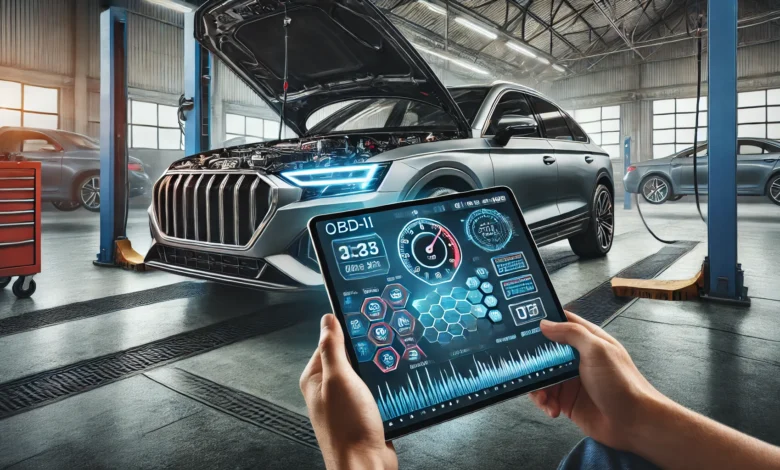Unlocking the Power of Advanced Diagnostics: A Comprehensive Guide to Efficient Automotive Connectivity

Introduction to Automotive Diagnostic Tools
In the rapidly evolving world of automotive technology, diagnostic tools have become indispensable for both car owners and mechanics alike. With the complexity of modern vehicles, understanding what’s happening under the hood has moved beyond basic mechanical knowledge. Today, advanced diagnostic tools allow for deep insights into vehicle health, performance optimization, and predictive maintenance. These tools aren’t just convenient—they’re essential for the longevity and safety of our cars.
Diagnostic tools serve as a bridge between the driver and the intricate systems within a vehicle. Gone are the days when an issue required guesswork or dismantling parts to diagnose a problem. Now, with the right diagnostic interface, identifying and fixing issues can be done swiftly, even without extensive mechanical expertise. The development of these tools has revolutionized car maintenance and enabled vehicle owners to stay proactive in managing repairs and upkeep.
As vehicle technology continues to advance, so does the sophistication of diagnostic interfaces. These devices now come equipped with enhanced connectivity, user-friendly interfaces, and compatibility with a wide range of platforms. From real-time fault detection to intuitive controls, modern diagnostic tools offer both professionals and DIY enthusiasts the ability to maintain their vehicles with ease.
Understanding Diagnostic Interfaces and Their Role
Diagnostic interfaces are central to modern automotive maintenance. These tools interact directly with a car’s on-board diagnostics (OBD) system, enabling users to access data from various systems within the vehicle. This data can include information about the engine, transmission, brakes, fuel system, and more. By offering insights into vehicle performance and pinpointing specific issues, diagnostic interfaces make it possible to keep a car running smoothly without frequent trips to the mechanic.
One of the standout features of these diagnostic tools is their ability to streamline the maintenance process. For automotive professionals, having a diagnostic interface can mean faster, more accurate repairs, leading to higher customer satisfaction and efficiency. For car enthusiasts or everyday vehicle owners, these tools empower them to take control of vehicle health, saving time and potentially high repair costs.
Exploring Key Features of Advanced Diagnostic Adapters
Modern diagnostic adapters bring an array of powerful features to the table, making them indispensable in automotive care. A notable advancement is the capability for real-time monitoring. This feature allows users to track performance metrics, such as engine RPM, temperature, and voltage, directly from their smartphone or tablet. With this data, users can make informed decisions about vehicle performance and address issues before they escalate.
Another critical feature is wireless connectivity. Many advanced adapters are Bluetooth-enabled, allowing users to connect wirelessly to the vehicle’s OBD system. This convenience eliminates the need for bulky cables and provides a more streamlined, user-friendly experience. Additionally, the cross-platform compatibility of these tools ensures they work seamlessly with multiple operating systems, enabling users to diagnose issues using any device, whether it’s a smartphone, laptop, or dedicated scanner.
VNCI 6154: A Game Changer in Automotive Diagnostics
VNCI 6154 has gained attention in the automotive diagnostic world for its powerful capabilities and ease of use. Designed to provide comprehensive diagnostic insights, VNCI 6154 is equipped with state-of-the-art features that make it suitable for both professional technicians and vehicle owners who prefer a hands-on approach to car care. The interface is designed to be user-friendly, allowing even those new to diagnostics to navigate and interpret data with confidence.
One of the most attractive features of VNCI 6154 is its compatibility with a wide range of vehicle makes and models. This adaptability is essential for users who may own multiple vehicles or work in repair shops where they encounter diverse vehicle types. Additionally, VNCI 6154 supports multiple operating systems, ensuring that users can access diagnostic information from a range of devices, further enhancing its flexibility and usability.
Benefits of Using High-Quality Diagnostic Interfaces
Investing in a high-quality diagnostic interface comes with numerous advantages. First and foremost, accuracy is significantly enhanced, as advanced diagnostic tools are built to detect subtle issues that might otherwise go unnoticed. This precision helps in identifying potential problems before they lead to costly repairs, thus extending the vehicle’s lifespan and ensuring safe operation.
Another benefit is the reduction of manual errors in diagnostics. When technicians rely solely on visual inspections or traditional tools, there’s a higher chance of overlooking critical details. High-quality diagnostic tools provide digital data, making it easier to detect and address issues with confidence. Additionally, these tools save time and effort, reducing the need for lengthy diagnostic procedures and allowing for quicker solutions to vehicle problems.
Efficient Troubleshooting with Advanced Diagnostics
One of the primary functions of a diagnostic tool is efficient troubleshooting, which can significantly reduce downtime and prevent unexpected breakdowns. Advanced diagnostic tools offer real-time fault detection, alerting users immediately if there’s an issue with the vehicle. By identifying faults early, these tools can prevent minor issues from turning into major ones, ensuring the vehicle remains reliable and safe.
For repair shops, this means faster service turnaround and higher customer satisfaction. For individual users, it provides peace of mind, knowing they have a reliable way to monitor their vehicle’s health. Many advanced tools can even store diagnostic history, allowing users to track recurring issues and understand long-term trends in vehicle performance.
The VNCI 6154A ODIS Diagnostic Tool supports advanced diagnostic functions across VW, Audi, Skoda, and Seat models, offering compatibility with the latest ODIS software versions and protocols like CANFD and DoIP, making it a versatile and cost-effective choice for comprehensive vehicle diagnostics.
How to Choose the Right Diagnostic Tool for Your Vehicle
Selecting the right diagnostic tool requires careful consideration of several factors. Firstly, compatibility is crucial; the tool must work with the specific make and model of your vehicle. Some diagnostic tools are designed for universal use, while others cater to specific car brands or systems. Additionally, it’s essential to consider connectivity options—whether a wireless tool is more suitable than a traditional wired one, depending on your preferences and convenience needs.
The software that accompanies the diagnostic tool also plays a significant role. Look for tools that offer regular updates and have an intuitive user interface, making it easier to interpret diagnostic data. Price and functionality often go hand-in-hand, so it’s worth considering whether the features offered justify the investment, particularly if you’re looking for a long-term tool for regular maintenance.
Key Features to Look for in Diagnostic Interfaces
Certain features can elevate a diagnostic tool from good to exceptional. Firmware update capability is one such feature, as it ensures that the tool stays current with evolving vehicle technologies. Frequent firmware updates allow for better compatibility with new vehicle models and improved diagnostic accuracy, which is essential in today’s fast-paced automotive industry.
Another important feature is user-friendliness. The interface should be straightforward to navigate, with a clear display of data and easy access to various functions. Some users may prefer tools with mobile app support, enabling them to view diagnostic data on their smartphones for added convenience. Additionally, the choice between wireless and wired options depends on personal preference, but wireless tools often offer a more seamless user experience.
Enhancing Vehicle Performance with Regular Diagnostics
Regular diagnostics aren’t just for identifying faults—they’re also essential for enhancing overall vehicle performance. By performing regular scans, drivers can spot small inefficiencies that, if left unchecked, may impact fuel economy or engine health over time. For example, an engine that’s running less efficiently might not only consume more fuel but could also cause wear on other components. Diagnostic tools allow users to catch these inefficiencies early, enabling them to make adjustments that optimize the vehicle’s performance.
Through diagnostics, users can also detect minor issues that could eventually turn into costly repairs. For example, a diagnostic scan might reveal that an oxygen sensor is underperforming, which, if left unchecked, could lead to issues in the exhaust system. By spotting and addressing such concerns early, users not only prevent costly repairs but also contribute to the overall longevity of their vehicle. Additionally, with real-time data tracking, drivers can monitor their car’s fuel consumption and adjust driving habits to improve efficiency.
Moreover, many diagnostic tools now offer suggestions based on detected issues, making it easier for users to understand and implement fixes. This proactive approach to maintenance ensures that a vehicle is always performing at its best, enhancing safety and extending its operational life. Whether it’s improving fuel economy or ensuring smooth engine operation, regular diagnostics can provide significant performance benefits for any vehicle.
Addressing Common Challenges with Diagnostic Tools
While diagnostic tools are invaluable, users may sometimes face challenges when using them. One common issue is connectivity problems, especially with wireless diagnostic tools. In some cases, users may find that their diagnostic tool has trouble connecting to the vehicle’s OBD port due to signal interference or compatibility issues. To mitigate this, it’s helpful to consult the user manual, ensure that firmware is up-to-date, and check that the vehicle’s OBD port is clean and accessible.
Another frequent challenge is understanding the data presented by the diagnostic tool. For users new to diagnostics, interpreting codes and metrics can feel overwhelming. However, many modern diagnostic tools provide detailed descriptions and recommendations alongside each diagnostic code, making it easier to understand what’s happening within the vehicle. Some tools even offer links to online resources or troubleshooting guides, which can be highly useful for new users.
Keeping firmware up-to-date is also crucial for smooth functionality. Firmware updates not only improve compatibility with newer car models but also introduce features that enhance the accuracy of the diagnostics. Regular updates can prevent the device from misinterpreting or missing certain vehicle signals, ensuring a more reliable diagnostic process. By following best practices and addressing these challenges, users can get the most out of their diagnostic tools.
Maintaining and Updating Diagnostic Tools
To ensure a diagnostic tool performs optimally, regular maintenance and updates are essential. Just like any other piece of technology, diagnostic tools require occasional care to remain in peak condition. Many advanced diagnostic tools offer automated firmware updates that keep them current with the latest vehicle technologies and protocols, which is critical for users who frequently work with newer car models.
Keeping the tool’s hardware clean and protected is equally important. Dust, moisture, and grime can affect the device’s performance, especially if the tool connects directly to the vehicle’s OBD port. Users should store the device in a protective case when not in use and avoid exposing it to extreme temperatures. Some tools come with protective caps for the connectors, which can help prevent dirt or damage to the pins, maintaining a good connection with the vehicle.
Finally, regular updates are crucial for accuracy. A diagnostic tool with outdated software might misinterpret codes or fail to recognize certain issues, potentially leading to incomplete or inaccurate diagnostics. Many manufacturers offer easy update processes, allowing users to connect the device to a computer or mobile app and download the latest software. Regular maintenance and updates not only improve the device’s functionality but also extend its lifespan.
Advancements in Diagnostic Technology and Future Trends
The field of automotive diagnostics is advancing rapidly, with new technologies reshaping how we understand and maintain vehicles. Artificial intelligence (AI) and machine learning are among the most significant advancements, as they enable diagnostic tools to “learn” from previous data, providing more accurate predictions and solutions. AI-driven diagnostics can identify patterns in data, predict possible faults, and even suggest the most effective repairs, making diagnostics smarter and more efficient.
Another exciting trend is the integration of cloud-based diagnostics. With cloud connectivity, diagnostic tools can store and analyze vast amounts of vehicle data, allowing for more precise diagnostics. Cloud-based tools also make it possible for users to access diagnostic data from anywhere, which is especially beneficial for fleet managers or repair shops that monitor multiple vehicles. The cloud also enables seamless updates, ensuring that the device always has access to the latest software and diagnostic protocols.
The future of diagnostic technology also leans toward IoT (Internet of Things) integration. As more vehicles become “smart” and connected, diagnostic tools will increasingly interact with other IoT-enabled devices, creating a comprehensive ecosystem for vehicle maintenance. This interconnectedness will facilitate real-time monitoring, remote diagnostics, and even predictive maintenance, transforming the automotive industry.
Integrating Diagnostics with Smart Vehicle Systems
As vehicles continue to integrate smart systems, diagnostics have evolved to become more sophisticated and interconnected. Many modern vehicles now feature IoT capabilities that allow diagnostic tools to sync directly with vehicle software, providing a real-time overview of all systems. With this integration, diagnostic tools can monitor and relay data on everything from fuel efficiency to tire pressure, offering a comprehensive view of the car’s condition.
For fleet managers, this integration is invaluable. Diagnostic tools can provide real-time updates on the health of each vehicle, allowing for proactive maintenance scheduling. For example, a diagnostic tool integrated with a fleet management system can alert the manager if a vehicle’s engine temperature is too high or if there are warning signs of a transmission issue. This information allows the manager to schedule preventive maintenance, reducing the risk of costly breakdowns.
Additionally, cloud-connected diagnostics enhance data accessibility, making it easy for users to view diagnostic reports from their smartphones or computers. This ease of access streamlines the process of tracking vehicle performance, identifying patterns, and addressing issues. Integrating diagnostics with smart vehicle systems not only enhances the safety and performance of individual vehicles but also provides a strategic advantage for businesses that manage large fleets.
DIY vs. Professional Diagnostic Tools: Which is Right for You?
When choosing a diagnostic tool, one of the primary considerations is whether to opt for a DIY or professional-grade device. DIY diagnostic tools are generally more affordable and user-friendly, making them ideal for casual users or vehicle owners interested in performing basic maintenance. These tools typically provide standard diagnostics and allow users to clear error codes, making them suitable for those who prefer to handle simple repairs themselves.
On the other hand, professional diagnostic tools are designed for technicians and offer more advanced features. These tools are usually compatible with a wider range of vehicles and can provide detailed data on complex systems. Professional-grade tools often come with extensive databases, access to technical support, and advanced diagnostic functions, which make them ideal for in-depth repairs and diagnostics. Although they require a higher upfront investment, professional tools are more comprehensive and suitable for those who need a tool for regular, detailed diagnostics.
Ultimately, the choice between DIY and professional tools depends on the user’s needs and level of expertise. For everyday car maintenance, a DIY tool can be highly effective. However, for technicians or car enthusiasts who want detailed insights into multiple systems, a professional-grade diagnostic tool may be the better investment.
Conclusion: The Impact of Advanced Diagnostics on Automotive Care
The evolution of diagnostic tools has had a transformative effect on automotive maintenance. Tools like VNCI 6154 and other advanced diagnostic adapters allow both professionals and car owners to monitor and maintain vehicle health with unparalleled ease and accuracy. By providing real-time data and insights into system performance, these tools have made it possible to detect issues early, prevent costly repairs, and optimize vehicle performance.
From enhancing fuel efficiency to reducing the likelihood of breakdowns, advanced diagnostics offer a comprehensive approach to automotive care. As technology continues to advance, these tools will likely become even more integrated into smart vehicle systems, offering deeper insights and more convenient access to data. Embracing these tools is not only a smart move for vehicle maintenance today but a step toward the future of automotive technology.

